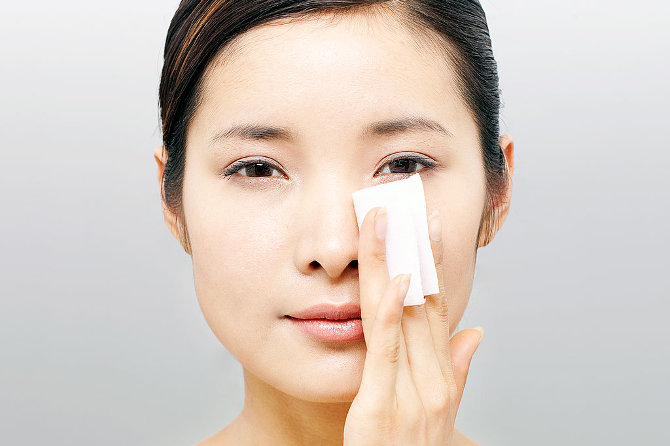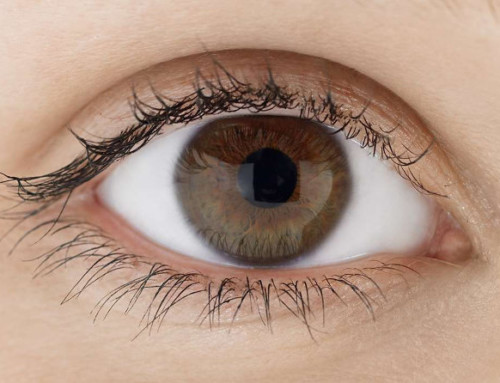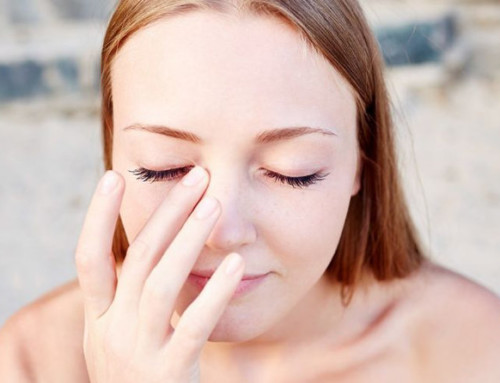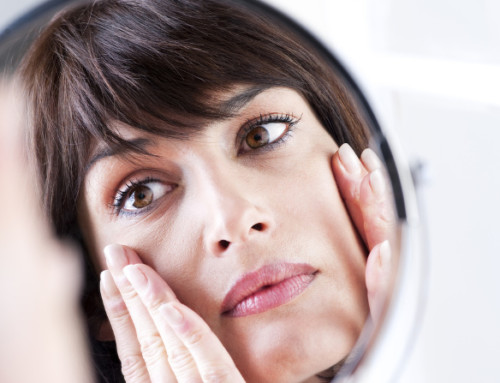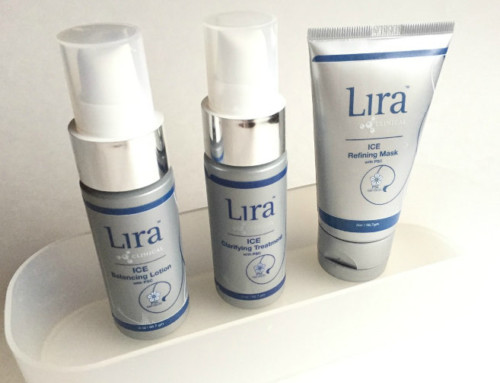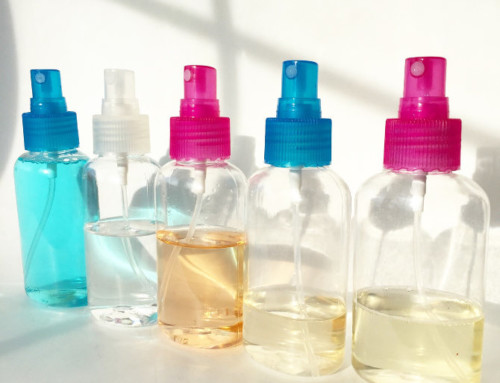Is your skin always shiny or does it shine later in the the day? If you answered yes, don’t feel bad! It’s perfectly natural and healthy to have some shine on your face. I understand the desire to be shine-free or less shiny, especially if you have oily skin. But in today’s post, I want to reassure you that oil is not a bad thing. Some surface oil, which is known as sebum, is critically necessary for your skin.
Why You Need Sebum
While I understand being very shiny all over isn’t exactly desirable, trying to achieve a shine-free look is an unhealthy path to take. Skin is designed to have some oil on its surface. That, in fact, is why you have sebaceous glands, which are attached to every follicle (hair or hairless) in your skin and scalp.
The sebaceous gland produces sebum (oil), which is released into the follicle (pore), which then flows out onto the surface of your skin. The role of this oil is to lubricate your skin and make it soft and pliable. If you didn’t have any oil, your skin would be brittle and inflexible. It wouldn’t move very well. But most importantly, oil creates a protective layer known as the acid mantle.
The acid mantle is a layer of oil and sweat mixed together on the outermost surface of your skin. You can’t see it, but it’s there. This layer, which exists at a slightly acidic pH, serves to protect you from microorganisms that could infect you (acidic pH deters not all but a portion of microorganisms), chemical irritants, pollution particles, and other ecotoxicants.
The acid mantle is also the first part of your skin’s barrier function (its ability to protect and maintain the skin’s integrity). The second part of your barrier function is the lipid bilayers in the epidermis, which hold your skin cells together and prevent water from evaporating too quickly.
If you strip away this acid mantle – for example by excessive cleansing or using an astringent toner with a lot of alcohol – you strip away your first layer of protection. In other words, you make your skin naked, exposing it to all the harsh elements in the environment. An analogy is going outside without wearing any clothes. You need clothing to protect yourself from extreme cold, heat, wind, dirt, bacteria, and physical abuse (like cuts and scrapes).
The consequence of stripping away this initial layer of oil is something you don’t want – skin that is set up to fail.
By that I mean you put your skin into a compromising situation – exposing and possibly impairing your barrier function. Now, every skin problem you have (or will have later) is aggravated further.
- If you normally have acne, you’ve increased the possibility of inflaming your skin, or more likely, you have just made the already underlying inflammation worse. Breakouts are more likely now!
- If you have rosacea or normally sensitive skin, you’ve just increased the likelihood of irritant reactions.
- If you have chronically dry or dehydrated skin, you’ve made it easier for water to escape.
How Much Oil Is “Normal”?
Oily skin shows shine first thing in the morning, upon waking. The shine is typically over the whole face or large parts of it.
Combination-oily skin will show shine in the T-zone in the morning. We produce more oil in the T-zone because there are more sebaceous glands there, and they are more active.
A ‘normal’ skin type displays shine in the T-zone by the end of the day. I fall into this group. While the shine may not be very obvious to you or others, it shows up more clearly in a photograph or video.
Dry skin (skin that genetically produces little oil) does not shine. There are very few people under the age of 60 who fall into this group. If you are under 60 and your skin feels dry, it is more likely due to dehydration and not because you have genetically dry skin. Mature skin (over the age of 60) will become more dry with age, due to the body’s natural decline of oil production.
Why Causes Oily Skin? Can You Change Sebum Levels?
Oily skin is regulated by hormones, testosterone to be exact. Testosterone activates the sebaceous gland, which produces oil. This is why men have oilier skin than women, and why in general, men need to moisturize less than women. (More facial hair in men is another reason.)
Because testosterone is controlled by your endocrine system, which is a highly complex system, and because the amount of oil you produce is genetically determined, there’s only so much you can do about the amount of oil you produce.
But there are habits you can control.
If you strip away sebum, your skin will only respond by producing more. Every aspect of your body strives to be in a state of homeostasis (balance). It will always try to auto-correct when it detects an imbalance.
You might wonder – Why can’t I temporarily remove the oil (to look good at least for a short while), because it will come back later anyway? Two reasons: Because when you strip away that sebum, you’re exposing your skin to harm (your skin barrier is vulnerable). And second, when the oil returns, you end up with more than you started with. You’re worse off than before.
It takes time for skin to return to a balanced state. While bad habits such as over-cleansing or picking at blemishes are tempting because they provide immediate gratification, they always put your skin on the defense. You end up having to wait even longer to achieve better skin.
Those of you who have acne may be asking – But I’m getting breakouts because of too much oil, what do I do then? Read on for the answer to that dilemma.
Sebum Control – Do’s & Don’ts If You Have Excess Oil
DO THIS
1. Use a cleansing oil at night. And if needed (you’re very oily), also cleanse with it in the morning. For those of you with acne or very oily skin, this will help immensely.
2. Better yet, do a Double Cleanse, which involves using a cleansing oil as the first step, and then a second cleanser. Again, definitely do this at night. And if very oily, also in the morning. If you’re not very oily, there is no need to Double Cleanse in the morning (it could be too drying).
3. Even better, be smart about your choice of a second cleanser. Pick one that has pore-clearing properties. Salicylic Acid and Glycolic Acid are good choices for oily skin because they exfoliate effectively.
4. Use oil-control products. Rather than stripping away oil manually (through cleansing or using an alcoholic toner), you can control oil production via ingredients that modulate oil production. This is a longer discussion for another day, but look for skin care lines that specialize in oily skin, which contain oil-control (absorb oil) or oil-regulating ingredients (these ingredients influence the variables that affect oil production).
I am biased here – professional skincare is the better place to look for these lines. The oil control ingredients are generally more sophisticated and the formulas are more gentle on skin. You’re less likely to encounter harsh products that strip too much oil (a problem with many retail acne products).
Here are some products (besides cleansers) that can help control oil:
- An exfoliating toner that you use daily after cleansing (once or twice depending on the manufacturer’s instructions).
- A clay-based mask that you use 1-3 times per week.
- An exfoliating mask that you use 1-3 times per week.
- An oil-control serum or moisturizer.
5. If you have acne, a professional acne regimen will contain ingredients that address oil and other factors that cause acne.
6. Blotting papers, tissue, paper towels – whatever is accessible/economical to you. Blot gently to absorb surface oil. Unlike a cleanser or toner, blotting touches the skin superficially and won’t impair your barrier.
7. Today’s makeup products and sunscreens also contain mattifying ingredients – these ingredients help to absorb oil and make skin look less shiny.
DON’T DO THIS
1. Don’t cleanse more than twice a day. Three times is ok if you have a sweaty exercise workout during the day. Or, if the weather is unbearably humid and you are sweating profusely in the middle of the day.
2. Don’t use an astringent toner (one containing a lot of alcohol, such as those you find in a drugstore) in an attempt to wipe off the oil. See #3.
3. Don’t use alcohol on your skin EVER. This is the worst thing you can do. Alcohol de-fats the skin – not just the surface oil, but the essential lipids inside the epidermis that are so crucial for keeping water inside skin and skin cells bonded together.
4. Don’t over-exfoliate. This is a common error. Follow the manufacturer’s instructions on frequency.
5. Don’t over-mask. Follow the manufacturer’s instructions on frequency.
6. If your skin ever feels tight after using a product, stop using it. Skin should not feel tight, unless you’re using a tightening product that temporarily tightens loose or sagging skin, but that sensation of tightness is totally different and much milder.
7. Foaming cleansers are tricky. Many of you I know like foam, and it is desirable when you have oily skin, but be careful. Some foaming cleansers are harsh. If your skin feels tight afterward, it’s probably too aggressive for your skin.
Contrary to what you might believe, foam isn’t necessary for oily skin. If you’re using a cleansing oil first, you will find there is much less need for a foaming cleanser afterward. An oil does all the hard work of clearing your skin of oil and dirt. It will do at least 80% of the cleaning. The second cleanser is doing the light lifting – the final clean to remove all grime thoroughly.
Many of today’s professional oily skin/acne cleansers are not foaming, or they are only mildly foaming. Yet they are effective at both cleaning and delivering key ingredients to fight oil or bacteria.
8. If your skin squeaks while cleansing, pay attention to your skin closely afterward – is it getting dry or irritated? You should not hear a squeak. A squeaking sound means a lot of oil is coming off. Don’t crave the squeak. Occasionally, I come across a cleanser or exfoliant that makes me squeak. I lay it to rest immediately.
Embrace Some Amount of Shine
Get comfortable with the idea of having some shine. We are so conditioned by the media to think shine is bad. Today’s models and celebrities are wearing mattifying makeup, and Photoshop is doing the rest to eliminate imperfections, including shine. This is a bad example for the rest of us who are not posing for magazine spreads.
You should embrace some shine. Obviously I’m not advocating that your face should be completely shiny all over. I just want to help you avoid the mistake of over-stripping your skin or get trapped into a vicious cycle of trying to be 100% shine-free, which is both not natural and not realistic.
Shine gives skin some glow too. Glow comes from both oil and smooth skin (how light reflects off a surface). You’ve seen people with dull, lifeless skin right? Do they have shine? No they don’t, which is partly why they look dull and lifeless.
Oil is also good for keeping wrinkles at bay. People with inherently more oil tend to age better later in life – fewer wrinkles, tighter and firmer skin for example. So if your oil bothers you now, take some comfort – you will be glad about it later!
Related Posts:
- The Double Cleanse Method
- Salicylic vs Glycolic Acid For Unclogging Pores
- Confused About Alcohol In Skincare? Here’s What You Need To Know
- The Skin’s Acid Mantle & Skin pH
- What Is Healthy Skin Exactly?
Want new articles delivered straight to your inbox? Sign up here.

